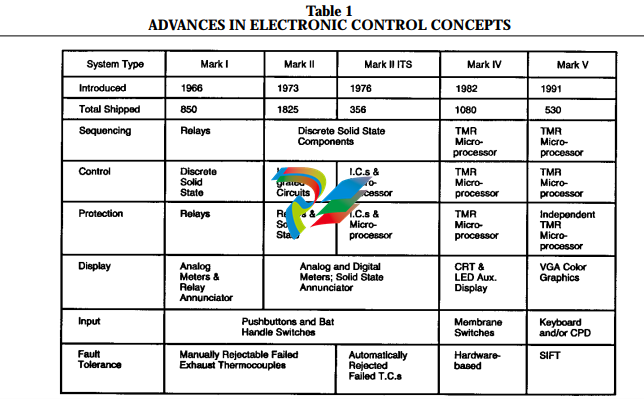
GESPEEDTRONIC™ MARK V GAS TURBINE CONTROL SYSTEM
Improvements in the new design have been
made in microprocessors, I/O capacity, SIFT
technology, diagnostics, standardization and
operator information, along with continued
application flexibility and careful design for
maintainability. SPEEDTRONIC™ Mark V control is achieving greater reliability, faster meantime-to repair and improved control system
availability than the SPEEDTRONIC™ Mark IV
applications.
As of May 1994, almost 264 Mark V systems
had entered commercial service and system
operation has exceeded 1.4 million hours. The
established Mark V level of system reliability,
including sensors and actuators, exceeds 99.9
percent, and the fleet mean-time-betweenforced-outages (MTBFO) stands at 28,000
hours. As of May 1994, there were 424 gas turbine Mark V systems and 106 steam turbine
Mark V systems shipped or on order.
CONTROL SYSTEM HISTORY
The gas turbine was introduced as an industrial and utility prime mover in the late 1940s with
initial applications in gas pipeline pumping and
utility peaking. The early control systems were
based on hydro-mechanical steam turbine governing practice, supplemented by a pneumatic
temperature control, preset startup fuel limiting
and manual sequencing. Independent devices
provided protection against overspeed, overtemperature, fire, loss of flame, loss of lube oil and
high vibration.
Through the early years of the industry, gas
turbine control designs benefited from the
rapid growth in the field of control technology.
The hydro-mechanical design culminated in the
“fuel regulator” and automatic relay sequencing
for automatic startup, shutdown and cooldown
where appropriate for unattended installations.
The automatic relay sequencing, in combination
with rudimentary annunciator monitoring, also
allowed interfacing with SCADA (Supervisory
Control and Data Acquisition) systems for true
continuous remote control operation.
This was the basis for introduction of the first
electronic gas turbine control in 1968. This system, ultimately known as the SPEEDTRONIC™
Mark I Control, replaced the fuel regulator,
pneumatic temperature control and electromechanical starting fuel control with an electronic equivalent. The automatic relay sequencing was retained and the independent protective
functions were upgraded with electronic equivalents where appropriate. Because of its electrically dependent nature, emphasis was placed on
integrity of the power supply system, leading to a
DC-based system with AC- and shaft-powered
back-ups. These early electronic systems provided an order of magnitude increase in running
reliability and maintainability.
Once the changeover to electronics was
achieved, the rapid advances in electronic system technology resulted in similar advances in
gas turbine control technology (Table 1). Note
that more than 40 years of gas turbine control
experience has involved more than 5,400 units,
while the 26 years of electronic control experience has been centered on more than 4,400 turbine installations. Throughout this time period,
the control philosophy shown in Table 2 has
developed and matured to match the capabilities of the existing technology. This philosophy
emphasizes safety of operation, reliability, flexibility, maintainability and ease of use, in that
order.
CONTROL SYSTEM
FUNCTIONS
The SPEEDTRONIC™ Gas Turbine Control
System performs many functions including fuel,
air and emissions control; sequencing of turbine
fuel and auxiliaries for startup, shutdown and
cooldown; synchronization and voltage matching of the generator and system; monitoring of
all turbine, control and auxiliary functions; and
protection against unsafe and adverse operating
conditions. All of these functions are performed
in an integrated manner that is tailored to
achieve the previously described philosophy in

the stated priority.
The speed and load control function acts to
control the fuel flow under part-load conditions
to satisfy the needs of the governor.
Temperature control limits fuel flow to a maximum consistent with achieving rated firing temperatures and controls air flow via the inlet
guide vanes to optimize part-load heat rates on
heat recovery applications. The operating limits
of the fuel control are shown in Figure 1. A
block diagram of the fuel, air and emissions control systems is shown in Figure 2. The input to
the system is the operator command for speed
(when separated from the grid) or load (when
connected). The outputs are the commands to
the gas and liquid fuel control systems, the inlet
guide vane positioning system and the emissions
control system. A more detailed discussion of
the control functionality required by the gas turbine may be found in Reference 1.
The fuel command signal is passed to the gas
and liquid fuel systems via the fuel signal divider
in accordance with the operator’s fuel selection.
Startup can be on either fuel and transfers
3
GER-3658D
Table 2
GAS TURBINE CONTROL PHILOSOPHY
• Single control failure alarms when running or during
startup
• Protection backs up control, thus independent
• Two independent means of shutdown will be available
• Double failure may cause shutdown, but will always
result in safe shutdown
• Generator-drive turbines will tolerate full-load rejection




























































































































